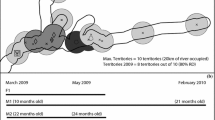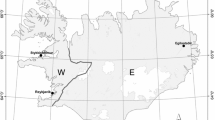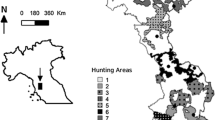Summary
To test the hypothesis that the incidence of infanticide should increase as population density increases in microtines (Mallory and Brooks, 1978), an index of pregnancy success was developed. There was no negative correlation between population density and pregnancy success in four species of Microtus and thus the hypothesis is refuted. There was a positive correlation between instantaneous growth rate and pregnancy success in M. pennsylvanicus and M. townsendii.
Similar content being viewed by others
References
Anderson JL, Boonstra R (1979) Some aspects of reproduction in the vole Microtus townsendii. Can J Zool 57:18–24
Andrzejewski R, Rajska E (1972) Trappability of bank voles in pitfalls and live traps. Acta Theoriol 17:41–56
Beacham TD (1979) Dispersal, survival, and population regulation of the vole Microtus townsendii. Ph D Thesis Department of Zoology University of British Columbia Vancouver BC
Bertram BCR (1975) Social factors influencing reproduction in wild lions. J Zool, Lond 177:463–482
Boonstra R (1978) Effect of adult townsend voles (Microtus townsendii) on survival of young. Ecology 59:242–248
Boonstra R, Krebs CJ (1978) Pitfall trapping of Microtus townsendii. J Mammal 59:136–148
Boonstra R, Krebs CT, Beacham TD (1980) Im pact of botfly parasitism on Microtus townsendii populations. Can J Zool 58:In Press
Brambell FWR (1948) Prenatal mortality in mammaals. Biol Rev 23:370–407
Bruce HM (1959) An exteroceptive block to pregnancy in the mouse. Nature: Lond 184:105
Clarke JR, Clulow FV (1973) The effect of successive matings upon bank voles (Clethrionomys glareolus) and vole (Microtus agrestis) ovaries. In: Peters, H (ed) The Development and Maturation of the Ovary and its Functions. Int Cong Ser 267 Exerpta Medica Amsterdam p 160–170
Clarke JR, Clulow FV, Greig F (1970) Ovulation in the bank vole, Clethrionomys glareolus. J Reprod Fert 23:531
Clulow FV, Clarke JR (1968) Pregnancy-block in Microtus agrestis an induced ovulator. Nature 219:511
Clulow FV, Langford PE (1971) Pregnancy-block in the meadow vole, Microtus pennsylvanicus. J Reprod Fert 24:275–277
Gaines MS, Vivas AM, Baker CL (1979) An experimental analysis of dispersal in fluctuating populations: demographic parameters. Ecology 60:814–828
Getz LL (1961) A population study of the vole, Microtus pennsylvanicus. Amer Midl Nat 64:392–405
Greenwald GS (1956) The reproductive cycle of the field mouse. J Mammal 37:213–222
Hoffmann RS (1958) The role of reproduction and mortality in population fluctuations of voles (Microtus). Ecol Monogr 28:79–109
Hrdy SB (1974) Male-male competition and infanticide among langurs (Presbytis entellus) of Abu. Rajasthan Folia Primatol 22:19–58
Innes DGL (1978) The reproductive tactics of two sympatric microtines. M Sc Thesis Department of Zoology University of Western Ontario London Ontario
Keller BL, Krebs CJ (1970) Microtus population biology III. Reproductive changes in fluctuating populations of M. ochrogaster and M. pennsylvanicus in southern Indiana. 1965–1967, Ecol Monogr 50:587–607
Kenny AMcM, Evans RL, Dewsbury DA (1975) Postimplantation pregnancy disruption in Microtus ochrogaster, M. pennsylvanicus, and Peromyscus maniculatus. J Reprod Fert 49:365–367
Kozakiewicz M (1976) Migratory tendencies in a population of bank voles and description of migrants. Acta Theriol 21:321–338
Krebs CJ (1966) Demographic changes in fluctuating populations of Microtus californicus. Ecol Monogr 36:239–273
Krebs CJ, Boonstra R (1978) Demography of the spring decline in populations of the vole, Microtus townsendii. J Anim Ecol 47:1007–1015
Krebs CJ, Keller BL, Tamarin RH (1969) Microtus population biology: demographic changes in fluctuating populations of M. ochrogaster and M. pennsylvanicus in southern Indiana. Ecology 50:587–607
Krebs CJ, Myers JH (1974) Population cycles in small mammals. Adv. Ecol. Res. 8:267–399
Krebs CJ, Wingate I, LeDuc J, Redfield J, Taitt M, Hilborn R (1976) Microtus population biology: dispersal in fluctuating populations of M. townsendii. Can J Zool 54:79–95
LeDuc JI, Krebs CJ (1975) Demographic consequences of artificial selection at the LAP locus in voles (Microtus townsendii) Can J Zool 53:1825–1840
Mallory FF, Brooks RJ (1978) Infanticide and other reproductive strategies in the collared lemming, Dicrostonyx groenlandicus. Nature 273:144–146
Mallory FF, Clulow FV (1977) Evidence of pregnancy failure in the wild meadow vole, Microtus pennsylvanicus. Can J Zool 55:1–17
Myers JH, Krebs CJ (1971) Genetic, behavioral, and reproductive attributes of dispersing field voles Microtus pennsylvanicus and M. ochrogaster. Ecol Monogr 44:53–78
Pelikan J (1970) Embryonic resorption in Microtus arvalis (Pall) Zool Listy 19:93–102
Rose RK, Gaines MS (1978) The reproductive cycle of Microtus ochrogaster in eastern Kansas. Ecol Monogr 43:21–42
Stehn RA, Richmond ME (1975) Male-induced pregnancy termination in the prairie vole, Microtus ochrogaster. Science 187:1211–1213
Schwagmeyer PL (1979) The Bruce effect: an evaluation of male/female advantages. Am Nat 114:932–939
Tamarin RH (1977a) Reproduction in the island beach vole, Microtus breweri, and the mainland meadow vole, Microtus pennsylvanicus, in southeastern Massachusetts. J Mammal 58:536–548
Tamarin RH (1977b) Dispersal in island and mainland voles. Ecology 58:1044–1054
Tamarin RH (1977c) Demography of the beach vole (Microtus breweri) and the meadow vole (Microtus pennsylvanicus) in southeastern Massachusetts. Ecology 58:1310–1321
Author information
Authors and Affiliations
Rights and permissions
About this article
Cite this article
Boonstra, R. Infanticide in microtines: Importance in natural populations. Oecologia 46, 262–265 (1980). https://doi.org/10.1007/BF00540135
Received:
Issue Date:
DOI: https://doi.org/10.1007/BF00540135




